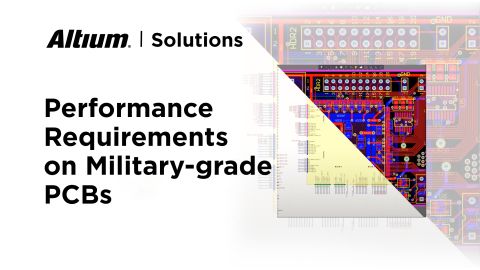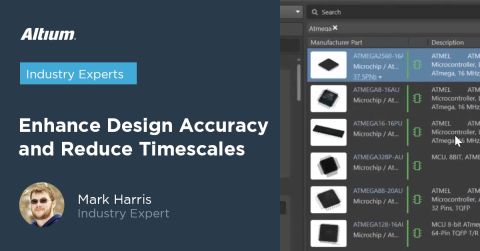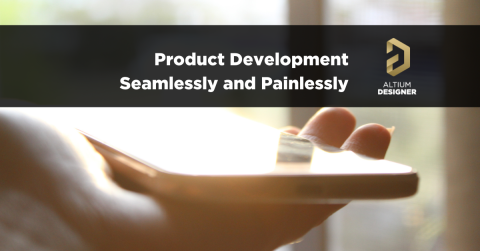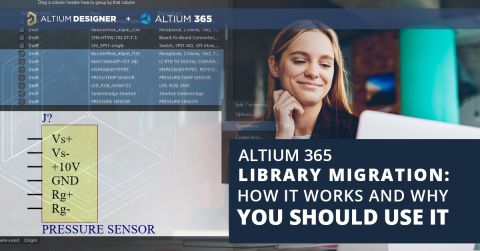Digital Input Sampling for Embedded Systems in Altium Designer

Whether or not you know it, embedded systems play an important role in providing broad functionality in a number of important applications, ranging from consumer electronics to military and aerospace systems. These systems must often gather analog signals and convert them to digital data, followed by using this data in complex calculations. There is plenty of other functionality to include in these systems in order to make them function as intended.
When you have access to a comprehensive library of components that interfaces directly with your design and simulation tools, you can easily design embedded systems with the functionality you need. Altium Designer unifies these important design elements into a single software platform, giving you the power to design the latest and greatest embedded systems for any application.
ALTIUM DESIGNER®
A unified PCB design package with the best tools for designing military electronics systems.
Here is one question that is asked by new designers: what is an embedded system? Although this might sound like some complex design that goes far beyond PCBs, the answer is not as complex as you might think. In reality, an embedded system is any system that integrates hardware and software into a single system. This system can be placed on a single board, or functionality can be spread across multiple boards.
The broad definition of an embedded system encompasses computers, mobile devices, smart devices, IoT, important systems in aircraft, industrial systems, and many other systems. As more electronics become mobile, intelligent, and connected, embedded systems design will continue to become a more important design methodology among PCB designers.
Creating embedded systems takes design software that integrates layout, schematic design, broad component management, and simulation features into a single program. Instead of trying to cobble together multiple design systems that separate these features, you can keep your next embedded system organized and improve your productivity when you work with Altium Designer. You’ll have access to the important design features you need to create embedded systems and take them through to production.
Digital Input Sampling for Embedded Systems
As embedded systems must interface with a variety of other components using analog signals and digital data, digital input sampling for embedded systems is extremely important. Many embedded systems will need to take analog signals as inputs using analog-to-digital converters (ADC). Some examples include wireless sensor networks and electromechanical systems.
Most people are familiar with audio systems, where a digital audio file is converted into an analog signal and output through a speaker system, or vice versa, where an audio signal is collected and stored in memory. Converting and storing this data requires choosing an ADC with the right sampling rate. The goal is to gather enough samples of an audio signal to be able to properly recreate the signal from digital data.
Choosing the Right Sampling Rate
Choosing the right sampling rate for an analog signal is all about preventing aliasing. This occurs when an ADC samples at a rate that is too slow, and the recreated signal appears to be at a lower frequency than the original sampled signal. Obviously, no analog sample can be sampled continuously, so designers need to choose the right sampling frequency for converting to digital data with an ADC.
As it turns out, the highest analog frequency that can be sampled with a sampling system, called the Nyquist frequency, is half the value of the sampling rate. In other words, an ADC needs to create at least two samples per oscillation of the analog signal. This is the reason why digital audio systems sample at 44.1 kHz (or 48 kHz for higher fidelity systems); the natural range of human hearing ends at 20 kHz, so there is no need to sample at a rate that is much higher than 40 kHz. Using 44.1 kHz as a sampling rate allows an ADC to sample at just beyond the range of human hearing.
When your PCB design software offers a unified data model that integrates a broad range of components with your layout simulation tools, you can easily select, place, and simulate the ADC and data processing components you need for your embedded system. Be sure that you are aware of the frequency of the analog signal you need to sample when choosing your ADC.
- If you haven’t added this functionality to your embedded system, Altium is here with guidelines to help you incorporate this important functionality into your embedded system.
See how to incorporate digital input sampling into your embedded system.
- Keeping your embedded system organized is easiest when you use hierarchical schematic and multi-channel design tools. Your PCB design software should help you stay organized while improving your productivity as your designs become more complex. See how you can use multi-channel design in your next PCB with Altium Designer.
- You might be considering using a PLC instead of an embedded system for your next device. See when you should choose a PLC over an embedded system.

Altium Designer unifies your design tools into a modern, customizable interface
Applications of Digital Input Sampling for Embedded Systems
Digital input sampling is used in embedded systems for several applications, including automotive, industrial, aerospace, and military systems. Many systems in these areas interface with a variety of equipment for monitoring the health of a major piece of industrial equipment, an automobile, or aircraft, just to name a few examples. In power electronics, an embedded system will often be used to gather data from a number of analog sensors for monitoring power integrity and output levels. There are plenty of other examples of embedded systems that gather analog signals.
Once analog signals are gathered with these systems, these signals are converted into digital data and processed within a larger digital system. This means that these devices are inherently mixed-signal devices, and important design rules for mixed-signal systems apply in these devices. Your PCB design software should help you build your embedded system to meet important design rules for ensuring signal integrity.
Designing any PCB as a mixed-signal device is much easier when you have design software that uses hierarchical design and multi-board design tools. This allows you to separate different portions of your embedded system into functional blocks. This helps you ensure signal integrity by allowing you to separate analog signal data acquisition from the digital input sampling and processing portions of your embedded system.
Simulating Signal Integrity in Embedded Systems
Data processing capabilities are critical in embedded systems, and you’ll need to include ADCs with the right sampling rate to gather data from other portions of the system. With data processing rates and requirements continually increasing in embedded systems, especially in cutting-edge applications. Embedded systems that crunch large amounts of data, such as IoT systems with artificial intelligence capabilities, are pushing the limits of embedded systems and require ever greater computing power.
Design software for embedded systems needs to include functionality that can help you ensure signal integrity throughout your embedded system. Designing embedded systems that control electromechanical systems, an analog-to-digital converter, include wireless communication capabilities, and other applications takes sophisticated mixed-signal design tools. You’ll also need access to component libraries with plenty of options for processors, ADCs, and other components.
- Combining hardware and software capabilities into a single embedded platform doesn’t have to be difficult. Altium Designer is here to show you the finer points of this design methodology and help you design successfully.
Learn more about the finer points of embedded systems design.
- Real-time embedded processing of digital data will inevitably require that your embedded system includes plenty of memory.
Learn more about the role of memory in real-time embedded data processing.
- An embedded system will require a standard or customized communication protocol that allows different blocks in your system to exchange data. Learn more about designing a communication model for your embedded system.

Multi-board design with ECAD/MCAD collaboration in Altium Designer
Designing Embedded Systems in Your PCB Design Software
Hopefully by now, you’ve seen that an embedded system is really just an extension of a simple PCB, albeit with greater functionality and capability requirements. Embedded systems perform many tasks that a simple PCB simply cannot, especially when one considers the analog signal data acquisition and processing functions included in many embedded systems.
With this in mind, your design software should include all the design features you need to place the required functionality within your embedded system, and all within a single design platform. With the right PCB design software, you can easily link your functional blocks together into a complete structure using hierarchical design and capture your design as an actual single-board or multi-board layout. With the best rules-driven design interface, you can define important requirements and standards for your application as design rules within your design software.
Altium Designer: The Only Unified PCB Design Platform
Staying at the forefront of embedded systems design takes access to the best design technology. Working within a unified design environment ensures your design features communicate using a single language. Your design will be verified against your design rules as you work, and you’ll have the ability to simulate important functionality and signal integrity in your embedded system.
Instead of using other design platforms that force you to switch between multiple programs, working with unified design software ensures that all your design tools are easily accessible within one program. Only Altium Designer gives you these features, allowing you to design your embedded system with mixed-signal, high-speed, and even high-frequency capabilities. Everything you need to design embedded systems is included in Altium Designer.
- With Altium Designer, your design features are all accessible within a single program. You’ll never have to switch to a separate design tool again when you use Altium Designer. Learn more about Altium Designer’s unified design environment.
- Modern systems for real-time embedded data processing must operate at high speed and require the best high-speed design tools on the market. Learn more about high-speed design in Altium Designer.
- If your embedded system is a multi-board system, you’ll need the right 3D design tools that unify MCAD and ECAD capabilities into a single program. This allows you to verify the electrical and mechanical functionality of your embedded system. Learn more about native 3D design for multi-board systems in Altium Designer.
Designing any embedded system can be a difficult task that requires the best design, simulation, verification, and production planning tools you can find. Other PCB design software platforms split these tools into different programs, forcing you to use an outdated workflow to complete even the simplest design tasks. Instead of getting stuck with a new version of outdated software, try working with Altium Designer. Only Altium Designer includes all the tools you need for embedded systems design in a single program. You only need to learn to use a single powerful interface within a rules-driven design environment.
Altium Designer is the only PCB design platform that combines the best embedded systems design features in a single platform. Altium also gives you the tools you need to be successful. You’ll have instant access to the AltiumLive forum, podcasts, and webinars with industry experts, design tutorials, and an extensive knowledge base. No other PCB design software company gives you this many resources for success.
When you choose Altium Designer, you’ll always have access to the resources you need to design an embedded platform successfully. Don’t settle for other design platforms that sap your productivity and make essential design tasks difficult. You can stay at the forefront of embedded system design within a single platform when you use Altium Designer.












